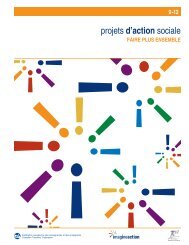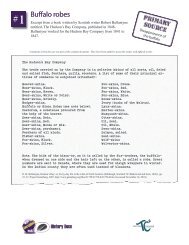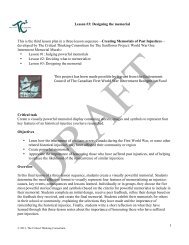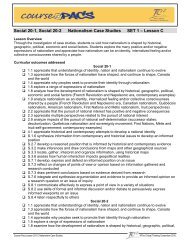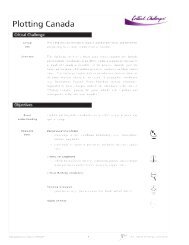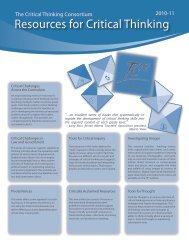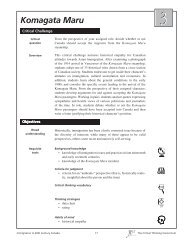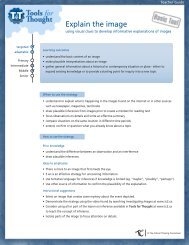– others– onesTEACHER RESOURCE #3➤➤Provide students with Persuasive devices: A starting list (ActivitySheet #3B), which outlines the particular persuasive device usedin each example on Activity Sheet #3A. Help students createtheir own example of each device.Persuasive devices: a starting listAppeal to emotions “Meet Zoe. She’s six and she– provoke empathy has leukemia. She’s not sure– use storytelling to “paint a visual she’ll get to celebrate her– picture for readers” seventh birthday. You can– suggest that if readers follow the course help her realize her dream– of action you suggest, they will belong of going to Disneyland if …”– to or be part of a groupDevice Example My own exampleACTIVITY SHEET #3BComparisons “For Zoe, walking up a set– use similes, metaphors, or analogies to of stairs is like climbing– help readers understand what some- a mountain …”– thing is like or to connect an abstract– concept to their personal experiencesAuthority/social proof “In Canada, 1,500 kids– convince readers by providing proof contract cancer every year.– of your own authority on the issue Your donations ensure– convince readers by providing facts, that …”– statistics, and quotations from experts, “Research conducted by …– or testimonials and referrals from tells us that …”Prediction “If we don’t do something– provide readers with a glimpse into now, our children and– the future grandchildren will not have– convince readers what the future will clean water to drink.”– look like if they follow the course of– action you suggest (or if they don’t)Repetition Using the same slogan on all– drive your point home by repeating advertising materials. For– important terms or a particular example, President Obama’s– metaphor or vivid image use of the phrase “Yes, weSentence structure Starting with a rhetorical– deliberately use a particular sentence question (“Who wouldn’t– structure at various points of the text want a loyal friend?”) orcan!” during the 2009 U.S.federal election campaign.– (for example, imperative, interrogative, ending a long explanation– exclamatory) or use short, simple with a short, imperative– sentences rather than long, complex phrase like “Just do it.”Tools for Thought 2008-09:3 24 © <strong>The</strong> <strong>Critical</strong> <strong>Thinking</strong> <strong>Consortium</strong>Practisethe strategy➤➤Use one or more of the following options so students can practisethe strategy.• Option #1: Revisit the list of activities in the introductoryactivity. Provide students with a copy of Planning for persuasivewriting (Activity Sheet #3C) and invite students toidentify persuasive devices to convince someone to takepart in one of the activities from this list. Point out tostudents the importance of choosing the most effectivedevice for the selected activity. Complete one exampleof a literary device with the class.• Option #2: Present the following task: EnvironmentCanada has challenged students to become more environmentallyfriendly. To win the challenge, everyonein the school must participate in a changeof behaviour that has positive environmental consequences.Convince students in your school to participatein this challenge. Provide students with copies of Planning for persuasivewriting (Activity Sheet #3C) and invite them to select an environmentallyfriendly activity and identify persuasive devices that will convince students and teachers toparticipate. Point out the importance of choosing the most effective device for the selectedactivity. Complete one example of a literary device with the class.• Option #3: Invite students to rework a piece of writing to makeit more convincing by incorporating persuasive literary devices.Provide pairs of students with one of the examples found inConvince me! (Activity Sheet #3D) or other selected writingsamples. Assign each pair a different persuasive techniquefrom Activity Sheet #3B. Instruct pairs to suggest how thetechnique might be used to make the writing more convincing,and to record their ideas on Activity Sheet #3C. Oncethey have finished, ask pairs to pass the writing sampleand Activity Sheet on to another pair who will use anotherliterary device. After several rotations, returnthe piece of writing to the original pair. Invite themto rewrite the piece incorporating all of their peer’sideas.Invite several pairs of students to present “before” andOverall planningPurpose: What am I trying to convince readers of?What action would I like the reader to take as aresult of reading this piece?Audience: Who am I trying to convince?Planning for persuasive writingDevice What words or phrases Deciding whether to use itcould I use?Appeal to emotions This device is:– provoke empathy ❏ very appropriate for my purpose & audience– use storyte ling to “paint a visual picture ❏ somewhat appropriate– fo readers” ❏ not appropriate– sugges that if readers fo low the course Rationale: ❏– of action you suggest, they wi l belong to– or be part of a groupComparisons This device is:– use similes, metaphors, or analogies to ❏ very appropriate for my purpose & audience– help readers understand what some- ❏ somewhat appropriate– thing is like or to connect an abstract ❏ not appropriate– concep to their personal experiences Rationale:Authority/social proof This device is:– convince readers by providing proof ❏ very appropriate for my purpose & audience– of your own authority on the issue ❏ somewhat appropriate– convince readers by providing facts, ❏ not appropriate– statistics, and quotations from experts, or Rationale:– testimonials and referrals from others–Prediction This device is:– provide readers with a glimpse into ❏ very appropriate for my purpose & audience– the future ❏ somewhat appropriate– convince readers wha the future wi l ❏ not appropriate– look like if they fo low the course of Rationale:– action you suggest (or if they don’t)Repetition This device is:– drive your point home by repeating ❏ very appropriate for my purpose & audience– importan terms or a particular ❏ somewhat appropriate– metaphor or vivid image ❏ not appropriateRationale:Sentence structure This device is:– deliberately use a particular sentence ❏ very appropriate for my purpose & audience– structure at various points of the text ❏ somewhat appropriate– (for example, imperative, interrogative, ❏ not appropriate– exclamatory) or use short, simple sen- Rationale:– tences rather than long, complex onesTools for Thought 2008-09:3 25 © <strong>The</strong> <strong>Critical</strong> <strong>Thinking</strong> <strong>Consortium</strong>Your Task:With a partner, rework the following piece of writing to make it more convincing.Convince me!Tools for Thought 2008-09:3 26 © <strong>The</strong> <strong>Critical</strong> <strong>Thinking</strong> <strong>Consortium</strong>ACTIVITY SHEET #3CACTIVITY SHEET #3D-1Steps:1. Focus on only one persuasive device. Record your ideas on Activity Sheet #3C.2. Exchange your work with another pair of partners who will use a different persuasive device.3. After several pairs have added their ideas, they will return the page to you.4. Read all the ideas your peers have suggested. Decide which ones to incorporate. Rewrite the piece usingthose ideas to make it more convincing.Writing Sample #1Tools for Thought 2008–09:3 21 © <strong>The</strong> <strong>Critical</strong> <strong>Thinking</strong> <strong>Consortium</strong>
TEACHER RESOURCE #3“after” writing samples with an explanation of which persuasive literary devices they used andwhy. Alternatively, instruct student pairs to copy their reworked piece onto chart paper and postit on the wall beside the original piece. Invite students to participate in a “gallery walk,” rotatingfrom chart to chart, using stick-on notes to identify strengths and make suggestions.➤➤Discuss with students the importance of using literacy devices with integrity. Point out that literarydevices could be used to deceive or exploit, even if for noble purposes in the end. For example, inorder to appeal to readers’ emotions, a writer might reveal private or embarrassing details about aperson’s life. You may wish to develop some parameters for ethical use of persuasive devices.Reinforcethe strategy➤➤Introduce Persuasive devices (Student Resource #3). Revieweach element: the purpose, strategies, sample use of the strategy,and the self-assessment rubric. Encourage students to refer tothis resource when using this strategy in the future. Discusswith students when this strategy might be useful in schooland out of school.Persuasive devicesusing literary devices to convince/p ersuadein a written piecePurposeThis strategy helps me convincea reader of the importanceof my topic. It also helpsme choose the best devicesbased on my purpose and myaudience.For a sample use of thestrategy, see the nextpageAPPLYthe strategySTUDENT RESOURCE #3• Identify your purpose for writing:− What are you hoping to convince readers about?− What action do you hope they will take after they have read yourpiece?• Identify the target audience:− Who are you trying to convince?• Consider each literary device:−−What opportunities are there to use various persuasive devices?Brainstorm possible words and phrases you might use.➤➤Invite students to use the literary devices to create a shortpiece of persuasive writing. As a class, select a relevanttopic. Suggestions might include: appealing to schooladministrators to change a school policy, proposingan initiative to student council, persuading someoneto read a book, collecting donations for a particularcharity, or convincing someone of the importanceof a historic figure.− Identify the most appropriate or effective devices for your topic andaudience.• Consider the ethical use of pversuasive devices:− Even if you have good intentions, will the use of some devices offendor mislead your readers or humiliate or embarrass others?Assessing my use of “Persuasive devices”Accomplished Good Basic StrugglingIdentifies persuasive devices when reading:I can easily use many I can use a number of I can identify the most I need help identifyingpersuasive devices persuasive devices, but I obvious persuasive basic persuasive devices.including complex or sometimes have trouble devices, but I am oftendifficult examples. labe ling some of the confused by the complexmore complex or difficult or difficult examples.examples.I use persuasive devices I use some persuasive I use a few persuasive I need help usingeffectively in a variety of devices, but I sometimes devices, but I have trouble persuasive devices.ways.have trouble using others. using others.Chooses persuasive devices that are appropriate for the purpose and audience:I can easily choose the I can usua ly choose I can sometimes choose I need help in choosingpersuasive devices that persuasive devices that appropriate persuasive persuasive devices that areare most appropriate are appropriate for either devices, but I am often appropriate to my purposefor my purpose and my purpose and audience, confused about which and audience.audience.but I sometimes have ones to choose.trouble satisfying bothrequirements.Uses different persuasive devices when writing:Tools for Thought 2008-09:3 29 © <strong>The</strong> <strong>Critical</strong> <strong>Thinking</strong> <strong>Consortium</strong>Apply the strategyto everyday teachingAssess the useof the strategy➤➤➤➤➤➤➤➤If poverty is a topic you wish to investigate with your students, use the materialon poverty found in this resource, and ask your students to write a persuasive letter tothe editor creating awareness of the issue of poverty in your community (<strong>Critical</strong> challenge #4).Encourage students to use self- and peer-assessment to refine their work prior to circulating it torelevant audiences.At appropriate times over the ensuing several weeks, encourage students to use this strategy inregular classroom situations, including the following:• identifying persuasive techniques in posters, advertisements, and other visual text forms;• identifying persuasive techniques in editorials, letters to the editor, essays, and other writtentext forms;• identifying persuasive techniques in speeches and other oral formats;• using persuasive techniques when presenting orally or in writing;• developing a supporting argumentEncourage students to refer to the rubric found in Persuasive devices (Student Resource #3) whenself-assessing their use of this literacy strategy:• Allow students opportunities to apply the strategy two or three times without evaluation.• Guide students in interpreting and using the rubric to assess their own responses.• Encourage students to use the rubric whenever they use this strategy.➤➤ To use the rubric for teacher evaluation of student work, remove the first person (student) referencefrom each descriptor.Tools for Thought 2008–09:3 22 © <strong>The</strong> <strong>Critical</strong> <strong>Thinking</strong> <strong>Consortium</strong>



